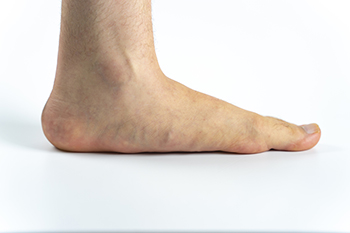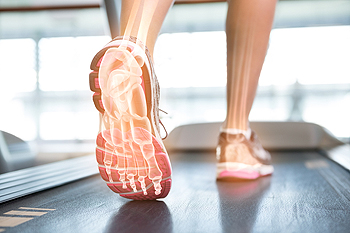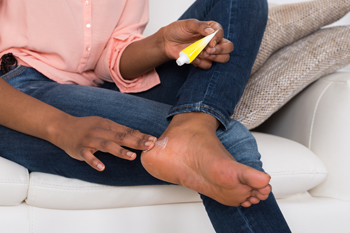Connect With Us
Blog
Items filtered by date: October 2022
Flat-Footed Runners

Most babies are born with flat feet, which will dissipate into adulthood. There are some individuals who continue to have flat feet beyond childhood, and this generally happens as a result of genetic reasons. It is noticeable while standing on the floor, and observing that the foot lies flat on the floor. It is a condition that can range from producing severe discomfort or no pain, and many people who have flat feet have learned to live with it. There is a large population of people who enjoy running, and this includes patients who have flat feet. Over-pronation, which is the degree of how much the foot rolls inward, is often related to having flat feet. The arch maintains support and provides shock absorption for the body, and this may be compromised in flat-footed runners. There are simple methods that can help to make running easier. These include maintaining a healthy weight, training effectively, and performing specific stretches that are geared toward people who have flat feet. If this condition applies to you, please consult with a podiatrist who can give you advice on how to run more efficiently.
Flatfoot is a condition many people suffer from. If you have flat feet, contact David Mansky, DPM from Mansky Podiatry. Our doctor will treat your foot and ankle needs.
What Are Flat Feet?
Flatfoot is a condition in which the arch of the foot is depressed and the sole of the foot is almost completely in contact with the ground. About 20-30% of the population generally has flat feet because their arches never formed during growth.
Conditions & Problems:
Having flat feet makes it difficult to run or walk because of the stress placed on the ankles.
Alignment – The general alignment of your legs can be disrupted, because the ankles move inward which can cause major discomfort.
Knees – If you have complications with your knees, flat feet can be a contributor to arthritis in that area.
Symptoms
- Pain around the heel or arch area
- Trouble standing on the tip toe
- Swelling around the inside of the ankle
- Flat look to one or both feet
- Having your shoes feel uneven when worn
Treatment
If you are experiencing pain and stress on the foot you may weaken the posterior tibial tendon, which runs around the inside of the ankle.
If you have any questions please feel free to contact our office located in Hastings, MI . We offer the newest diagnostic and treatment technologies for all your foot and ankle needs.
The Feet Are Complex, and Have Several Categories

The feet are an interesting and complex part of the body. Each foot is composed of 26 bones and several muscles, ligaments, and tendons that work together to provide mobility and balance to the body. Additionally, the feet carry the weight of the body, and are designed to absorb shock while running and walking. Research has indicated there are three types of foot postures. Humans and animals have the foot structure that is known as plantigrade, and is observed as the entire foot striking the ground while walking. The digitigrade posture is seen in dogs and cats, and is noticed as only the toes are on the ground while walking or running. Animals that run, such as horses, possess the unguligrade posture, and this is seen as a few of the toes touching the ground while running. The human foot has three parts, consisting of the hindfoot, midfoot, and forefoot. Within each foot are bones that are divided into three categories, including tarsus, metatarsus, and phalanges. There are many more parts that make up each foot, and if you would like to know more about how the feet are structured, please confer with a podiatrist.
If you have any concerns about your feet, contact David Mansky, DPM from Mansky Podiatry. Our doctor can provide the care you need to keep you pain-free and on your feet.
Biomechanics in Podiatry
Podiatric biomechanics is a particular sector of specialty podiatry with licensed practitioners who are trained to diagnose and treat conditions affecting the foot, ankle and lower leg. Biomechanics deals with the forces that act against the body, causing an interference with the biological structures. It focuses on the movement of the ankle, the foot and the forces that interact with them.
A History of Biomechanics
- Biomechanics dates back to the BC era in Egypt where evidence of professional foot care has been recorded.
- In 1974, biomechanics gained a higher profile from the studies of Merton Root, who claimed that by changing or controlling the forces between the ankle and the foot, corrections or conditions could be implemented to gain strength and coordination in the area.
Modern technological improvements are based on past theories and therapeutic processes that provide a better understanding of podiatric concepts for biomechanics. Computers can provide accurate information about the forces and patterns of the feet and lower legs.
Understanding biomechanics of the feet can help improve and eliminate pain, stopping further stress to the foot.
If you have any questions please feel free to contact our office located in Hastings, MI . We offer the newest diagnostic and treatment technologies for all your foot and ankle needs.
Get Professional Care for a Broken Foot or Ankle
Signs of Cracked Heels

One of the many unsightly and unattractive conditions of the feet is known as cracked heels. Also known as heel fissures or split heel, this condition occurs when the skin on the heel becomes exceedingly dry. There are several signs of cracked heels that you can be on the lookout for. First, the most obvious sign of cracked heels is a developing callus on the heel that can be either a shade of yellow or brown. If the condition is relatively new, you might notice small cracks in the hardened skin callus. However, if this condition is older and has not been treated for a long period of time, then there may be deeper cracks in the callus. These deeper cracks might even bleed in severe cases, inviting infection. If you notice any of these signs, or you believe that you might have cracked heels, do not hesitate to schedule an appointment with a podiatrist today.
Cracked heels are unsightly and can cause further damage to your shoes and feet. If you have any concerns, contact David Mansky, DPM from Mansky Podiatry. Our doctor can provide the care you need to keep you pain-free and on your feet.
Cracked Heels
Cracked heels appear unappealing and can make it harder for you walk around in sandals. Aside from looking unpleasant, cracked heels can also tear stockings, socks, and wear out your shoes. There are several methods to help restore a cracked heel and prevent further damage.
How Do You Get Them?
Dry skin is the number one culprit in creating cracked heels. Many athletes, walkers, joggers, and even swimmers suffer from cracked heels. Age and skin oil production play a role to getting cracked heels as well.
Promote Healing
Over the counter medicines can help, especially for those that need instant relief or who suffer from chronic dry feet.
Wear Socks – Wearing socks with medicated creams helps lock in moisture.
Moisturizers – Applying both day and night will help alleviate dryness which causes cracking.
Pumice Stones – These exfoliate and remove dead skin, which allows for smoother moisturizer application and better absorption into the skin.
Change in Diet
Eating healthy with a well-balanced diet will give the skin a fresh and radiant look. Your body responds to the kinds of food you ingest. Omega-3 fatty acids and zinc supplements can also revitalize skin tissue.
Most importantly, seek professional help if unsure how to proceed in treating cracked heels. A podiatrist will help you with any questions or information needed.
If you have any questions, please feel free to contact our office located in Hastings, MI . We offer the newest diagnostic and treatment technologies for all your foot care needs.
Ways Diabetics Can Care For Their Feet

As a diabetic, foot problems can become a major concern. The result of long-term high blood sugar levels often leads to neuropathy, which can endanger the health of the feet and lower limbs. A daily foot care routine is imperative to help avoid foot ulcers and other conditions that could lead to gangrene or limb removal. Experts recommend the following measures that can help to protect your feet. Reserve time each day to check the feet for sores, wounds, and cuts, especially those that seem to be taking a long time to heal. Wear shoes that fit properly and do not rub or pinch. Keep your feet elevated whenever possible. Do mild foot and toe exercises to keep them moving and encourage blood flow to the area. Check for signs of inflammation or infection by being aware of unusual changes in the temperature of your feet. Avoid wearing anything tight around the legs and ankles, as that can restrict blood flow. Also, avoid smoking, which increases the risk of serious problems. It is strongly suggested that as a diabetic you schedule regular appointments with a podiatrist who is equipped to help manage foot-related complications from this disease.
Diabetic foot care is important in preventing foot ailments such as ulcers. If you are suffering from diabetes or have any other concerns about your feet, contact David Mansky, DPM from Mansky Podiatry. Our doctor can provide the care you need to keep you pain-free and on your feet.
Diabetic Foot Care
Diabetes affects millions of people every year. The condition can damage blood vessels in many parts of the body, especially the feet. Because of this, taking care of your feet is essential if you have diabetes, and having a podiatrist help monitor your foot health is highly recommended.
The Importance of Caring for Your Feet
- Routinely inspect your feet for bruises or sores.
- Wear socks that fit your feet comfortably.
- Wear comfortable shoes that provide adequate support.
Patients with diabetes should have their doctor monitor their blood levels, as blood sugar levels play such a huge role in diabetic care. Monitoring these levels on a regular basis is highly advised.
It is always best to inform your healthcare professional of any concerns you may have regarding your feet, especially for diabetic patients. Early treatment and routine foot examinations are keys to maintaining proper health, especially because severe complications can arise if proper treatment is not applied.
If you have any questions please feel free to contact our office located in Hastings, MI . We offer the newest diagnostic and treatment technologies for all your foot and ankle needs.
Blog Archives
- April 2025
- March 2025
- February 2025
- January 2025
- December 2024
- November 2024
- October 2024
- September 2024
- August 2024
- July 2024
- June 2024
- May 2024
- April 2024
- March 2024
- February 2024
- January 2024
- December 2023
- November 2023
- October 2023
- September 2023
- August 2023
- July 2023
- June 2023
- May 2023
- April 2023
- March 2023
- February 2023
- January 2023
- December 2022
- November 2022
- October 2022
- September 2022
- August 2022
- July 2022
- June 2022
- May 2022
- April 2022

